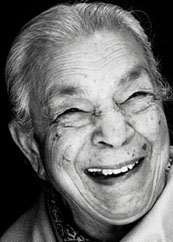
Zohra Segal (April 1912- July 2014)
Sohail Hashmi
ZOHRA Segal was born in a family of Rohela Pathans in Saharanpur in 1912. It has become fashionable to add the prefix ‘conservative’ before Rohela Pathan, and this is done to highlight the fact that she chose dancing and acting as a career. Obviously the prefix helps reinforce the image of the Muslim as intolerant and posits Zohra as the rebel and therefore abnormal as far as the Muslims were concerned.
Such biographies paper over the fact that in the early 20th century there were not too many educated families in India and among this small number there were even fewer families, whether Muslim or Hindu or belonging to any other denomination, who wanted their children especially girls to become performers - dancers, actors, singers.
Such ‘authentic’ notes also do not talk about the fact that Zohra’s elder sister Uzra was an actor and was already a leading lady at Prithvi Theatre when Zohra and her husband Kameshwar moved to Bombay from Lahore in the mid-1940s. Zohra probably joined Prithvi because her sister was already there. Another fact that is rarely talked about is the communist connection in the family. Zohra’s elder sister Hajra Begum married the well-known Communist Z A Ahmad. So three out of the five sisters are ‘rebels’; add to this the fact that it is Zohra’s maternal uncle who takes her to England to learn theatre and then on to Germany to learn dance and you have a remarkably open and tolerant family unlike the picture of orthodox Rohela Pathans that many biographical notes on Zohra Segal would like to paint.
The times in which Zohra Segal and her siblings were growing were remarkable times, all over the world people were rising against every kind of constrictions – economic, social and cultural. Powerful movements were heralding epochal changes and in the forefront were movements for emancipation from imperialism, from poverty, from hunger and from all manner of discriminations based on gender, birth and colour.
These were the times in which Zohra, named at birth as Sahibzadi Zohra Begum Mumtaz-Ullah Khan, grew and went to school in a convent that observed strict pardah, male speakers, on the rare occasions when they were invited to school, addressed the students from behind a curtain. But no curtains or walls have ever succeeded in shutting out ideas and the desire for freedom and so Zohra dreamt of becoming an actor and a dancer. She had the courage of conviction to strive and make her dreams a reality and she did.
But becoming a dancer and an actor was not all that she did, she made very significant choices in her life and each one of them indicates that Zohra Segal, lived according to deep-seated tolerant and inclusive traditions, traditions that were the bulwark of the anti-imperialist struggle that evolved and shaped an entire people during her growing years. In those days, girls were married to boys chosen by their parents; both had to belong to the same community and social status and the girl had to be younger. And what did Zohra do? She married a man she loved, a Hindu, a dancer and eight years her junior and she did it at a time when communal passions and communal politics were on the rise all over the sub-continent.
1945 was the year she joined Prithvi Theatre, this was also the year she joined IPTA. The IPTA along with the PWA were the organisations that gave literary and cultural expression to the aspirations of the people to be free from the yoke of imperialism and to build a society based on equality of opportunity for all. IPTA produced two films, Dharti Ke Lal by Khwaja Ahmad Abbas on the Bengal Famine and the other Neecha Nagar directed by Chetan Anand an adaptation by K A Abbas of Gorky’s Lower Depths.
Zohra came into IPTA after performing all over the world for five years as the lead dancer of Uday Shankar’s dance troupe and after teaching at his dance academy, after performing as the lead dancer of Kameshwar’s opera Lotus and after running a dance training institute Zohresh that she and her husband had set up at Lahore. She was at the peak of her career and could have bagged roles in many commercial films that were being made in Bombay at that time, but what does she do? She chooses political cinema. Zohra Segal remained committed to progressive ideas and retained her links with progressive and secular organisations. She recited progressive poetry of Faiz Makdoom, Majaz and Sahir like no one else could. Her performances for SAHMAT particularly for 140th anniversary of 1857 Revolt in front of Red Fort and 75th anniversary of Jallianwalla Bagh in front of Gyrah Murti are really memorable. She remained an integral part of the Artists against Communalism Campaign.
So when we pay tribute to Zohra Segal we pay tribute not only to a great artist but to a great human being as well. A great human being, who had the courage of her conviction and the sense of humour to thumb her nose at empty rituals. How many people have the courage to do all she did, as long as she did, and to leave a will saying “I do not want any ritual, I want to be taken to an electric crematorium and cremated. If they insist that my ashes be collected I want them to be flushed down the toilet hatch.” Long Live Zohra Segal. You were one of a kind.


